There's no stopping winter, so here are a few important and practical barn winter tips to help you make your homestead winter-ready!
Barn Winter Tips | Getting The Barn And Livestock Ready
Transitioning between seasons on a homestead opens new doors for new opportunities and challenges. Throughout the years, I’ve ensured my livestock's dwelling place is genuinely climate-proof and requires only minimal alterations for regular weather changes. However, your homestead might need help getting there, so I’ve pulled together some barn winter tips to help you during the winter.
Livestock And Barn Winter Tips You Must Remember

Imagine this scenario: During evening chores, the scoop scrapes the bottom of the grain can and you remember that you have been meaning to make a grain run all week
It’s too late in the day to make it all the way into town before the big feed store closes, but you measure out portions carefully and are able to just squeak by. The weather service was calling for a little snow tomorrow afternoon, but nothing serious. And besides, you can easily get to town and back before it starts.
That night on the news, the weatherman says that the few inches that had been forecast before are going to be more like a foot. And oh – surprise! It’s starting overnight tonight instead of later in the day. The hour round trip is going to be more like two in bad weather, and you don’t even want to think of the possibility that they’re out of your favorite brand again. But even though the storm may not prevent you from getting to the feed store, it might have caused their deliveries to be delayed.
It happens. And more often than one might think. Keeping livestock doesn’t happen in a vacuum, but instead, takes place in a hubbub of other activities and responsibilities. Farmers stay busy with outside jobs and fixing meals and attending their grandson’s football games and helping their kindergartner make cupcakes for the class and getting repairs done on their cars, and sometimes things slip through the cracks.
It’s a good idea to tend to livestock needs right now so that when the rest of life comes steamrolling through this winter, there will be one less thing to worry about.
Raising animals varies greatly from one farm to the next. A hundred dairy cows in a big circa 1800’s barn, or a herd of hefty beef cattle that run wild year round, or a handful of backyard goats in a shed-roofed shelter, or a flock of laying hens – everyone’s livestock needs are different. However, there are a few basic needs that are common to most places in winter. Every animal needs water, food, shelter, and safety. Focusing on those five requirements will get you and your livestock through most situations, and the following is a list to help you remember it all.
1. Wear The Proper Clothes
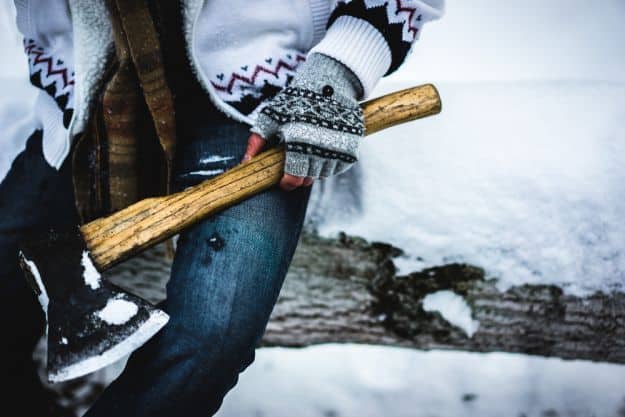
Before you go outside to feed your livestock, clean the stalls and begin your basic barn chores, the first thing you'll have to consider to help make your winter barn tasks easier is to wear the appropriate clothing. While it's tempting to dress like the Michelin man to wander out for stable errands, mobility remains a problem. Layering is the way to mobility and comfort. When you begin cleaning stalls and dumping buckets, you'll warm up quickly, so the ability to shed layers is essential. Begin with a base layer of silk long clothing or stockings to wick away dampness.
2. Keep The Water Supply Running
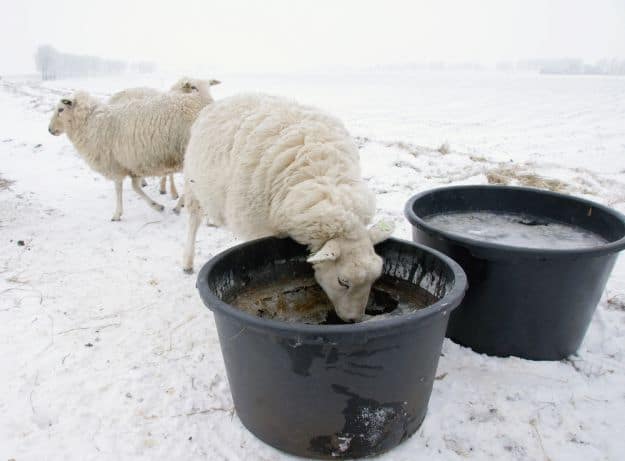
Give some thought as to how you will keep water from freezing. I carry warm tap water out to the barn twice a day for my very small herd of goats, and for my chickens too.
Some people use special plug-in watering dishes that heat the water enough to keep it from freezing. Others devise ingenious ways of insulating, blanketing, and mulching the water containers to minimize freezing. Whatever is best for you, make a plan to do it now. Don’t wait until the farm store is sold out of the thing you wanted to use.
3. Have A Stock Of Food
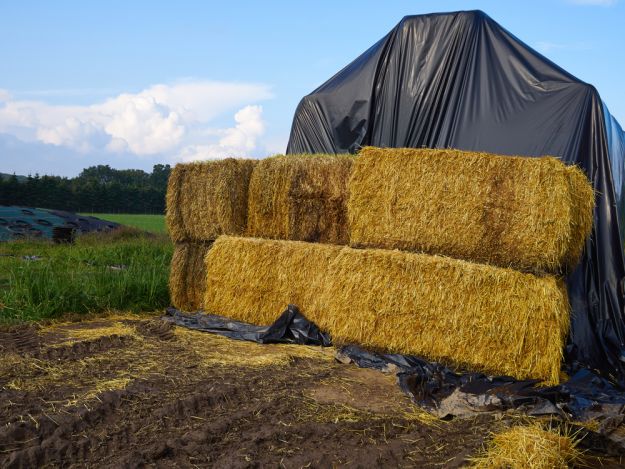
Hay is the cheapest and best right out of the field in summer, and if you were lucky enough to stock up on all you’ll need back in July, great!
Otherwise, you’ll want to get it now. A little math work will help you make sure you get enough. Keep track of how many bales you go through in a week, multiply that by the number of weeks until there is realistically sure to be fresh graze available, and pad that number by twenty percent.
If you lack storage space for an entire winter’s worth, keep tabs on hay availability. Some years are better hay years than others, and if you know it’s been a lean one, don’t take chances. Last year our hay farmer confided in us that he was worried he’d run out by January. We reassessed our supply in December and decided to go back for a few more than we had planned on, just in case.
He did run out midwinter, as did most hay farmers in the state, and it was a winter for the record books. Most people were really scrounging for hay by spring, but we had just enough.
Store extra grain, supplements, and top dress feed. We have big non-working chest freezer at our farm for animal feed storage.
As soon as we take a fifty-pound bag out, we put it on the list to be replaced – except at this time of year, we replace it with two. Different sized operations are more or less able to stock up, but it’s a good idea to stay at least a few extra weeks ahead on feed. Snowstorms, cold snaps, spills, and accidents can all dip deeply into your grain stores when you can least afford it.
4. Make Your Shelter Winter Ready
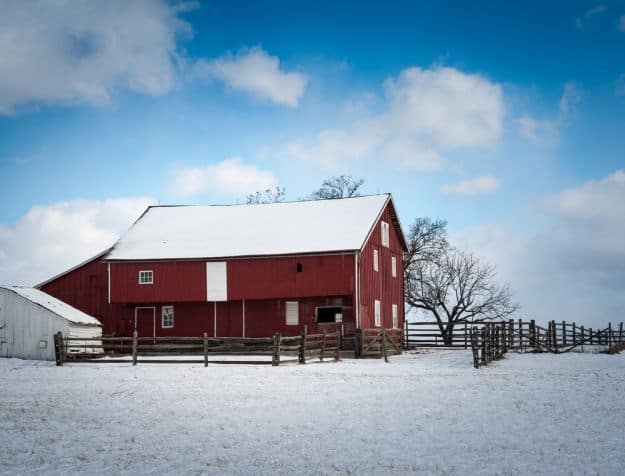
Is that hole in the east wall of the cowshed patched up? Do the shingles on the barn roof in need of some repairs? Don’t leave that stuff at the mercy of Mother Nature over the winter.
Additionally, this is the perfect time to make seasonal changes to animal housing. Close up the windows, stuff in insulation – made of paper, hay, synthetic materials, or plastic bubble wrap – wherever you need to, fill in holes around the foundation, and any other winterization that needs to be done.
If you use heat lamps in frigid temperatures, now is a great time to get them out of storage and get them set up. Inserting hooks for hanging is a lot more challenging at ten below zero, and you won’t want to wait until the chickens are freezing to find out that your heat lamp bulb is burnt out.
Don’t forget the bedding. Shavings, sawdust, straw – whatever you use, make sure you get a little ahead on your supplies.
5. Ensure Everybody's Safety
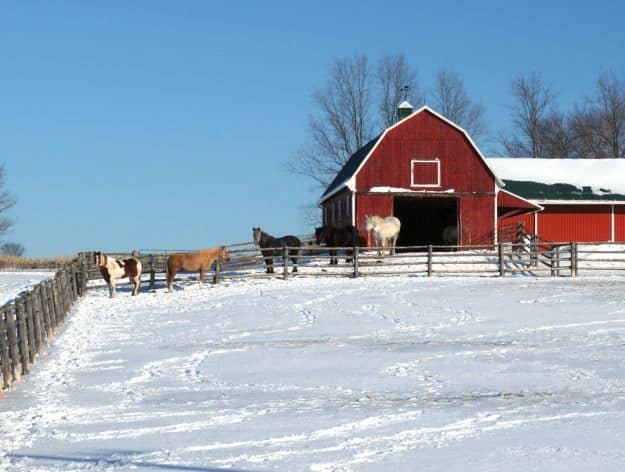
You will want to keep your livestock in their pens, for their safety and yours. Make sure your fences are in good shape. If they are leaning or loose now, they certainly won’t support a snow load in January.
Remember, you won’t be able to pound new fence posts in then, either. Shore them up now, even if the best you can do is a temporary fix.
Check your gates. You’ll want solid latches and hinges in good repair before snow flies.
If your fence posts have sunk into the ground over time so that your gate is barely clearing the ground, you might want to raise it up a little to clear packed snow and ice. Consider the direction the gates open, too. For our first winter, we had a gate to the goat pen that opened in and opening it after a major snowfall was like plowing snow with the gate. It was challenging enough that we made it a point to put different hinges on it that next summer, and now the gate opens both in and out.
If you use portable electric mesh, it is the time of year to be vigilant about the weather. A big early snowstorm can knock your fence down into the snow, and a sudden freeze-up can cement your posts into the ground. It is made of thin delicate wiring designed to carry a heavy electric charge but not able to withstand a heavy load of snow or ice. We like to keep ours out as late in the year as we can, and we have cut it pretty close some years. More than once, we have found ourselves racing around the field and forest pulling up hundreds of feet of fencing, sometimes in twenty-degree sleet or by flashlight.
Beyond the five basic homestead need, there are a few other barn winter tips to remember to make your life easier while caring for livestock in winter. First, you’ll want to have a sturdy shovel and a good supply of deicer for your barnyard access and to clear gates and paths for the animals to move around. And don’t forget to check your supply cabinet or tack room – if it’s unheated, move all the liquids and equipment that can be damaged by cold into the house.
Need more livestock and barn winter tips? Check out this video from AQHA Video:
With animals, and in life in general, there are no guarantees that everything will go as planned. You cannot prevent every accident and plan for every contingency. But if you pay real attention to the four basic needs of your livestock right now, life will be easier for humans and animals alike when your winter life starts to happen.
How do you prepare for winter? Did you find these barn winter tips helpful and interesting? Let us know what are your thoughts about these barn winter tips in the comments section below.
Up Next: 8 Winter Readiness And Safety Tips For Homesteader
Follow us on Facebook, Instagram, Pinterest, and Twitter!
Editor’s Note – This post was originally published on December 2016 and has been updated for quality and relevancy.


Leave a Reply